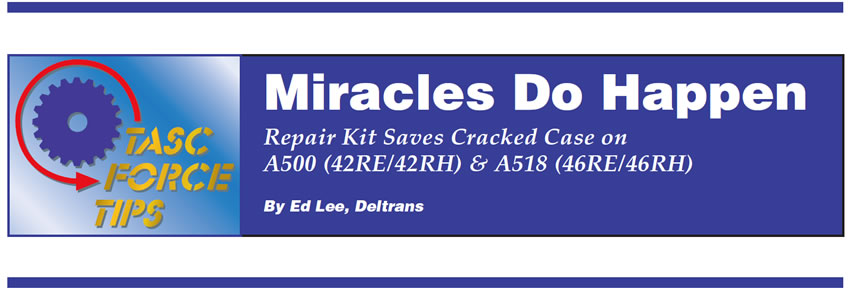Good Vibrations: 4T60-E Differential Problems
A customer comes into your shop in a GM vehicle with a 4T60-E transmission that’s making a lot of noise no matter what speed the car is going but is quiet as long as there’s no wheel movement, or possibly no movement at all. You do the basic diagnostics, pull the pan and discover that the pan is full of metal, and upon disassembly you find the differential parking-gear bearing is blown. Or, even worse, a unit you just repaired a couple of months ago comes back with one of these problems.

No Lockup for No Reason?
Here’s a real-life example of a problem that came into our shop. A 1998 Chevrolet pickup with a 4L60-E was brought in with complaints of no reverse, no 2nd and no 4th gear. We figured this was a routine job. In fact, it’s usually a “gravy” job. We started the job by scanning for codes and found P1870 and P0300.

4T65-E’s and the Mysterious Code P0730
A 2001 Buick Century Custom came to a transmission shop with a complaint of jerky shifts. A road test of the vehicle showed that all shifts were harsh, and a scan check registered the generic gear-ratio-error code P0730. Since code P0730 does not illuminate the malfunction-indicator light, the harsh shift was the customer’s only clue that anything was wrong.

Miracles Do Happen
A 1995 Jeep Grand Cherokee was brought to a Cottman Transmission shop in Jennings, Mo. The customer‘s complaints were typical for this model transmission and correct for the mileage of the vehicle. A complete transmission and converter rebuild were sold and, because of the chronic cooler-line problems, a cooler-line update was sold for added security.

Diagnostic Dilemmas
So what is fuel trim? Fuel trim is rebalancing the fuel mixture for reduced emissions. It is a number that represents the computer’s learned amount of total fuel need. That number is derived from the time the fuel injectors are pulsed on and off. The higher the fuel-trim number, the more fuel is being commanded, the more injector pulse-on time. The lower the number, the less fuel is commanded, the less the injector is pulsed on. The fuel-trim command is a result of what the oxygen sensor tells the computer. You don’t want to see short-term fuel trim over 10 on your scan tool. Fuel trim starts at 0 and can go positive (more fuel) or negative (less fuel).

AX4S or AX4N?
Their turbine-speed sensors look similar but won’t interchange.
At first glance you might think the AX4S and AX4N turbine-speed sensors are the same. However, a closer look will show you that the AX4S sensor is a little longer – which means you easily could install the wrong sensor in a unit by mistake.

Repeat Catastrophic Lube-Related Failures
Most transmission technicians who work on rear-wheel-drive Chryslers are all too familiar with the devastation associated with poor lubrication. Galled governor supports, galled and/or seized output shafts, or rounded sun and planetary gears are all common failures (see Figure 1). Although towing a vehicle with the drive wheels on the ground will yield the same results, the vast majority of failures are caused by a simple lack of or insufficient lubrication.

Checking Valve Bodies With a Homemade Hydraulic Test Stand
There are several ways to check valve bodies for wear: wet air tests, wiggle tests, deflection measurements, vacuum gauges or the hydraulic test stand, the last of which is the focus of this article. In our shop I needed to be able to measure the leakage accurately and record the findings before and after the repair, and be able to print the results on paper to hand to my customers.

Micro Cleaning
Cleaning’s not technical, right? You take a little soap and water and scrub and wash, scrub and wash some more, rinse, and the part’s clean. Or maybe you use some solvent, different chemical cleaners to get the really hard stuff and get it looking like new, so clean you can eat from it.

Transmission Coolers, Part 2
Auxiliary coolers have been available for almost as long as automatic transmissions have. For many of us who have been around a while, most auxiliary coolers were used to supplement the factory transmission cooler for towing or other heavy-duty purposes. In the TASC Force Tips article “Contamination and Coolers” in the August issue, we discussed the need to replace some coolers, but I realized that there are no guidelines for choosing the right-size cooler to install.

Problems With Metric Cooler-Line Fittings
Few things slow down an R&R job like frozen cooler-line fittings. The metric cooler-line fittings used in Isuzu 4L30 applications and Toyota trucks with A340/30-40LE (see Figure 1) are frustrating enough to make you want to reach for the tubing cutter and start cutting rather than struggle with stubborn lines.

KM End-Clutch Failure
Have you ever noticed that most of the complaints or failures you have with a KM involve a burned end clutch? The complaints tend to be sliding 1-2, 2-3 spin-up, neutraling on the 3-4 shift, delayed engagements, no forward or no reverse.
I’ve seen every one of these complaints, only to find the end clutch burned. You might be thinking, “What does a burned end clutch have to do with a sliding 1-2 shift?”

